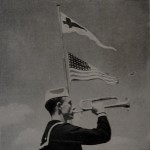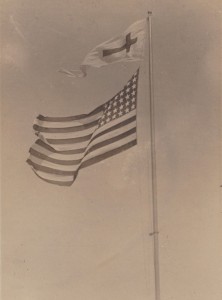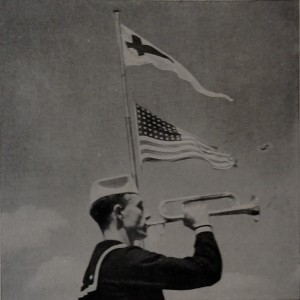When the Flag Must Yield

According to United States Code (U.S.C.) Title 4, §7, (c) “No other flag or pennant should be placed above or, if on the same level, to the right of the flag of the United States of America…” This law reserves the place of honor to the national flag while on U.S. soil, territories, military bases, ships, etc. (with exception granted to the headquarters of the United Nations in New York).
Most Americans know this law even if they don’t know where to find it. Its intent is to prescribe the prominence of the symbol of the United States over that of “States, cities, … localities, or … societies.” It is this law that defines the order of placement of flags when flown in front of buildings, on staffs inside churches and other buildings, even while carried in parades.
What most people don’t know however, is that there is a notable exception written into federal law. An exception that permits one thing -one pennant- to fly in the place of prominence above the flag of the United States. This law essentially permits the emblem of the United States of America to yield prominence to something else.
The flag of the United States yields only to church services aboard Navy vessels.
According to U.S.C. approved by Congress on 2 June 1942 the United States flag flies above any other flag or pennant “except during church services conducted by naval chaplains at sea, when the church pennant may be flown above the flag during church services for the personnel of the Navy.”
 Early on, the flying of the “church pennant” above the national flag was simply Navy tradition used “as a signal by ships at sea to denote to other ships that Divine Service is being held on board the vessel where the pennant flies.”1
Early on, the flying of the “church pennant” above the national flag was simply Navy tradition used “as a signal by ships at sea to denote to other ships that Divine Service is being held on board the vessel where the pennant flies.”1
This tradition wasn’t looked on with favor by everyone. In 1923 a group of patriotic organizations met at a conference in Washington, D.C. to formulate and recommend law for the proper presentation and treatment of the flag of the United States. The members of this conference “looked with disfavor upon the Navy custom of hoisting the church pennant over the national emblem as a signal the Divine Services were in progress.”2
Not only by this conference, but disapproval was also expressed by some Congressmen. In years following, the Secretary of the Navy was even called before Congress to answer whether any pennant flew above “the Stars and Stripes” on Naval vessels.3
 As the United States entered World War II however, with the extreme support given to the military services and their members during times of war, the practice was codified into U.S. law to permit this Navy tradition to continue, as it does to this day. According to Jonathon Maloney, a Navy Chaplain at sea as of the time this writing, the church pennant is flown above the national colors “every Sunday when I am holding services on Ship.”4
As the United States entered World War II however, with the extreme support given to the military services and their members during times of war, the practice was codified into U.S. law to permit this Navy tradition to continue, as it does to this day. According to Jonathon Maloney, a Navy Chaplain at sea as of the time this writing, the church pennant is flown above the national colors “every Sunday when I am holding services on Ship.”4
So by federal law, this one exception exists that places the identification of the presence of the chaplain and the performance of worship above the emblem of the United States of America.
.
.
.
1Clifford Merrell Drury, “The History of the Chaplain Corps, United States Navy, Vol. 2, 1939-1949.” NAVPERS 15808, pg. 123.
2 Clifford Murray Drury, “The History of the Chaplain Corps, United States Navy, Vol. 1, 1778-1931.” NAVPERS 15807, pg. 229.
3 Ibid.
4 Facebook Messaging conversation between author and Chaplain Jonathon Maloney, 30 September 2017.
.
.



